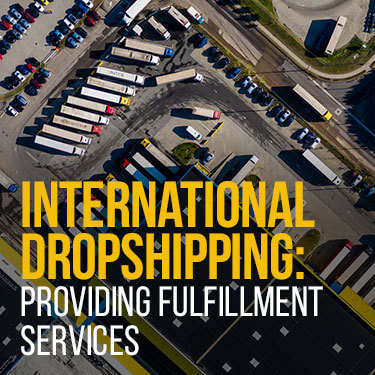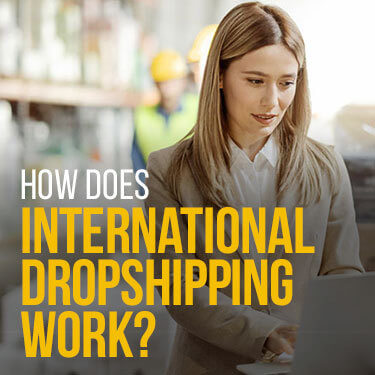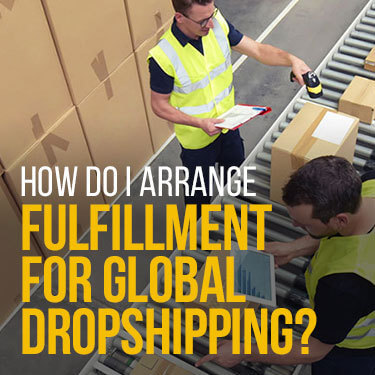
 Copy URL to Clipboard
Copy URL to Clipboard
International dropshipping has been presented by many as the ultimate work from anywhere business. There are no warehouses or office buildings, only you and a laptop. Like most things that seem too good to be true, international dropshipping has downsides and struggles that need to be met head on if you want to succeed.
Most dropshipping involves using international suppliers to both source and ship products to customers anywhere in the world. Fulfillment processes will depend on the relationship between the dropshipping business and the supplier. Services such as returns processing and package tracking vary quite a bit among suppliers.
At Fulfillment and Distribution, we present our clients with a variety of service options and can let you know what works based on our many years of experience in the logistics industry.
Table of Contents

When operating a dropshipping business, you act as a third-party facilitator to connect customers with suppliers.
As such, a drop shipping business does not maintain inventory or a physical store. International dropshipping is the ultimate eCommerce business model in the sense that it can take place almost anywhere in the world.
How does someone make money as a dropshipper? It all starts with establishing a store on an eCommerce platform.
Instead of buying inventory in bulk, you advertise your products and then have a checkout set up in a way that allows the buyer to buy the product straight from the supplier. Your profit comes from the difference between the actual price of the product and what you charged the customer.
| Cost of product from supplier | $3.00 |
| eCommerce store price | $10.00 |
| Shipping costs | $4.00 |
| Customer payment | $14.00 |
| Initial profit | $6.00 |
While this is a very simplified example, it does breakdown how a drop shipper makes money. Of course, those six dollars of initial profit are going to get broken down further.
The model here also assumes that the customer will pay for the full cost of any shipping and handling. While this is common in drop shipping, you will face competition from other eCommerce platforms that offer free or reduced shipping.
Before running off with your laptop to travel the world, there are many other considerations. We’ll present some possible pitfalls that someone wishing to start a dropshipping business needs to know.

Learning how to dropship internationally and be successful means becoming familiar with why so many dropshipping startups fail in the first place. From market research to shipping options, we’ll review some of the bigger issues for you to avoid.
When dropshipping businesses fail, it’s usually because of the following reasons:
Dropshipping is like any other business in that it needs attention and dedication to be successful. For the many positives that are often touted, there are negatives that even experienced entrepreneurs could find challenging.
Before you can start selling products, you need to determine what and where you want to sell.
Successful online stores tend to cater to niche markets that get ignored by bigger retailers. The trick is finding a product that is in high demand but with few competitors.
In 2022, some of the best performing dropshipping businesses focused on products such as:
Choosing one of these product categories is not a guarantee of success. It can steer you in the right direction, but be prepared to deal with a couple of false starts.
Many people new to dropshipping want to find the cheapest products possible to mark up for resale.
There are several issues with that business model:
Quality products matter when you want to build a business. Long-term success takes more than an artificial profit margin.
Half of choosing the right product is choosing the right market. As a default, many people in the U.S. who start a dropshipping business target American audiences. The problem is that the U.S. is a very saturated market. There isn’t much that buyers can’t get with just a click - and with free delivery.
Since dropshipping doesn’t rely on bulk orders or inventory maintenance, it’s okay to aim for an audience on the other side of the world.
Whatever the destination country, take time to study any regulations that may prevent products from entering.
In the same way customers are everywhere - so are suppliers. Once you know which products to focus on, it’s time to find a reliable way of getting them to customers.
Common issues with suppliers include:
Some of these issues are avoidable. Be picky about your suppliers and vet their merchandise and methods. There are even fulfillment services now that you can order through that will provide a tracking number even if the supplier doesn’t.
Realize that everything costs something. Added tracking could cost the customer more, and may raise the price past the point people are willing to pay.
Long delivery times are a perfect example. An item traveling from China to the U.S. takes about 20 days to arrive. That’s 20 days for your customer to search around and possibly find something that will deliver faster or for a cheaper price.
Every business needs marketing to make sure people know about it. Many drop shipping businesses fail because the people starting them either don’t spend the money to advertise, or they do so on the wrong platforms.
Many dropshipping platforms offer advertising services, though usually as an added cost. The same can be said of various popular social media platforms. It can also take significant trial and error to find which social platforms work best.
Completely ignoring your customer after they have purchased a product is a great way to guarantee item returns, bad reviews, and a failed business.
Even though the product goes straight from the supplier to the customer, that doesn’t mean you should consider yourself out of the loop. You may find yourself working with a supplier that has great products, but bad customer communication habits.
Being a responsive seller means being available for questions involving:
Being responsive is only part of the customer service battle. Good customer service also comes in the form of an informative website with solid design. Remember, you don’t have a physical store with people to help, so you need to make sure that your eStore is customer friendly.
Useful elements to have on a website include things like:
Even if your website is targeting an audience outside the U.S., ADA compliance is more about making sure you don’t exclude any potential customers. Most elements of ADA compliance have to do with appearance rather than language use, so it’s useful in international dropshipping.
Mastering the business aspects of international dropshipping still leaves you with the legal and logistical parts to handle.
If you’re shipping internationally, regardless of the origin or destination, there are laws you need to follow.
Since the drop shipper is the one making the sale possible, any legal backlash falls on them rather than the supplier or customer. Depending on the issue, you might deal with anything from fines to jail time.
Basic legal requirements for an international dropshipping business include:
Tax laws are still catching up to eCommerce business models, so this is something you really need to pay attention to. Every country is going to have slightly different rules. The U.S. has different rules on a state-to-state basis even.
Some countries require prior notice of deliveries. Others will expect you to pay taxes on goods sold within their borders. Some products are actually illegal to sell in some places due to local customs.
Always check the laws and regulations of destination countries before selling there. You may find that certain tax systems just aren’t worth the hassle.

Dropshipping on a global scale opens up amazing opportunities for business expansion, but not every supplier ships everywhere. Global dropshipping may require you to make arrangements with a local fulfillment agency.
Even when suppliers can handle fulfillment, that still leaves you with the issue of returns. One way suppliers keep prices low is to charge for or deny returns entirely. This can be a big problem for dropshippers because they can end up on the hook to refund the cost of the product and the shipping.
Management options here include:
There are a number of U.S.-based 3PLs that offer reverse logistics, including us here at Fulfillment and Distribution. Making a plan for handling returns needs to happen before one ever comes across your desk.
With international shipments there are just as many options. On the downside, you may need to contract the services of a local expert to help you out.
Unless you plan on mastering the language of every country you sell in, chances are you’re going to need to make at least some local connections.
Again, much of this depends on your supplier. If you do need to use local fulfillment, your best bet is to bring in a freight forwarder. Even if you aren’t providing bulk dropshipping services, a freight forwarder will have the international connections you need.
At this point, you’re either really excited about international dropshipping or you’ve decided to look into more traditional eCommerce possibilities. In either case, the experts at Fulfillment and Distribution are here to help.
Our experienced warehouse managers have helped customers with all kinds of services.
Call us today at (866) 989-3082 to speak with a warehousing and fulfillment expert to see what your options are. Have more immediate needs? Get a risk-free services quote online now.
